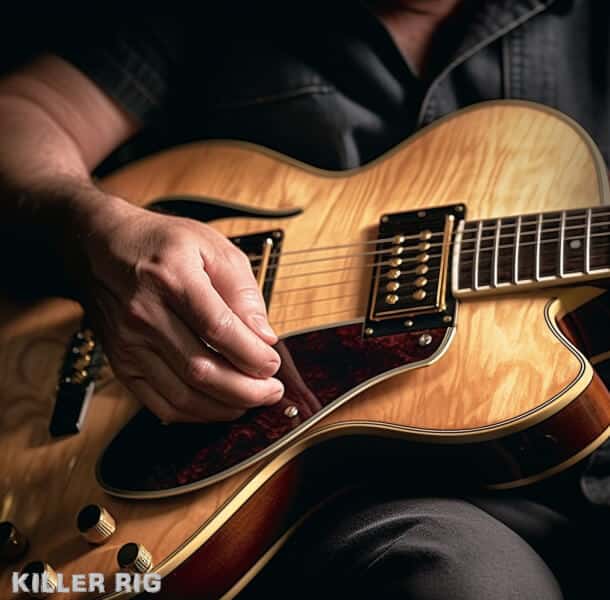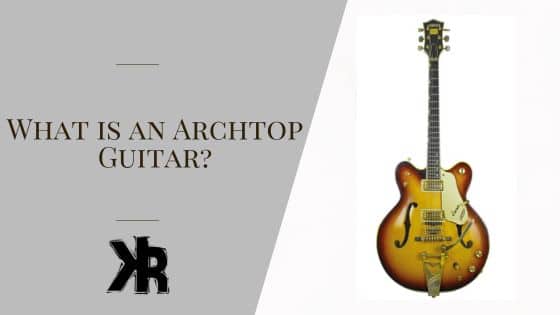Table of Contents
Have you ever wondered about the beautiful, curvy guitars that you see jazz and blues musicians playing on stage? Those are called archtop guitars.
They have a special history and sound that sets them apart. But what is an archtop guitar, and what makes them so special?
An archtop guitar is a kind of semi-acoustic guitar, known for its curved top, F-shaped soundholes, and strong association with jazz and blues music.
They have been played by legendary musicians like Charlie Christian and Wes Montgomery, and hold an important place in the history of music.
In this Killer Rig article, we will explore the history, features, and famous players of archtop guitars.
We will also compare them to others like flat tops and solid-body electric guitars. So, get ready to learn all about the amazing archtop and its role in the music world!
The Story of Archtop Guitars
The history of archtop guitars is rich and colorful, reflecting the evolution of music and the preferences of musicians over time.
From Banjo to Guitar
In the early days of jazz music, banjos were the go-to instruments for rhythm sections in orchestras. Mainly because of their bright and punchy sound that could cut through the mix.
However, as jazz music evolved and orchestras grew in size, the need for a more versatile and richer sounding instrument became apparent. This led to the emergence of the archtop guitar as a staple in jazz and blues bands.
The enhanced projection and perceptible punchiness made it a perfect fit for the rhythm sections, where it could both lead and provide backing for other instruments.
The smooth and mellow tone of the archtop guitar also allowed it to adapt to various styles of music. This made it a popular choice among musicians of different genres.
Orville Gibson: The Archtop Guitar Creator
Orville Gibson, an inventive luthier, is the man credited with designing the first archtop guitar. He combined elements from the violin family with features of guitars and mandolins to create an innovative instrument.
These were primarily features like the curved top and F-shaped soundholes. Gibson’s creation featured a larger body size, which helped increase the guitar’s resonance and volume, making it ideal for jazz and blues music.
How Archtop Guitars Have Changed
Since Orville Gibson’s initial invention, archtop guitars have undergone various modifications and improvements. All to cater to the important needs of musicians.
Some of these changes include the introduction of steel strings, which provided a brighter sound and increased sustain.
Another major development was the incorporation of pickups, transforming the design into semi-acoustic and hollow-body electric guitars. This allowed musicians to amplify their sound, making it easier to perform in large venues.
Additionally, as jazz and blues music continued to evolve, so did the design of archtop guitars. Luthiers began crafting handmade guitars with certain aesthetics and features, catering to the specific preferences of individual musicians.
Some of these customizations include variations in body shape, wood choices, and hardware. This has led to a wide range of archtop guitars available today.

Archtops and Flat Tops: What’s the Difference?
Understanding the differences between archtop and flat top guitars is essential to appreciate the characteristics of each instrument.
Comparing the Shapes
Archtop guitars are known for their unmistakeable curved tops, which are carved from solid wood, often spruce. This curvaceous design, inspired by the violin family, not only adds to their visual appeal but also contributes to their specific sound.
Flat top guitars are much different. They have a flat soundboard, typically made of spruce or cedar. These designs, which include parlor guitars and most acoustics, are commonly used in a wide range of music genres.
How Do They Sound Different?
The sound differences between them can be attributed to their contrasting body structures and soundholes.
Archtops, with their curved tops and F-shaped soundholes, produce a well-defined, mellow tone with less sustain compared to flat tops. This makes them ideal for jazz and blues music, where a more controlled sound is often desired.
Flat top guitars, with their flat soundboards and round soundholes, generate a brighter and more resonant tone. They also have a longer sustain, which makes them suitable for various music styles like folk, country, and rock.
The use of steel strings in many flat top guitars further enhances their brightness and projection, contributing to their versatile nature.
The Archtop Guitar’s Relationship with Jazz Music
Archtop guitars have become synonymous with jazz music over the years. In this section, we will delve into the reasons behind this strong connection.
Why Archtop Guitars Sound Great in Jazz
The acoustic qualities of archtop guitars make them especially well-suited for jazz music. Their curved tops and F-shaped soundholes contribute to a warm, mellow tone, with a sharp punchiness. This complements the complex rhythms and harmonies found in jazz.
These tonal characteristics allow archtop guitars to blend seamlessly with other instruments in a jazz ensemble.
The adaptability of archtops is further amplified by their ability to be used as acoustic, semi-acoustic, or electric guitars. Making them versatile and practical for a variety of performance settings.

Famous Jazz Guitar Players
Throughout history, many renowned jazz guitarists have embraced archtop guitars as their instrument of choice. Charlie Christian, a pioneering jazz guitarist, played a Gibson ES-150, which was one of the first commercially available electric archtop guitars.
His innovative playing style and use of amplification paved the way for the popularity of archtops in jazz music.
Wes Montgomery, another legendary jazz guitarist, was known for his signature thumb-picking technique and his affinity for archtop guitars.
He played a Gibson L-5 CES, which became synonymous with his name. And later, a custom-built Gibson named the Wes Montgomery Model.
Other notable jazz guitarists, such as Neal Casal and Jon Herington, have also favored archtop guitars for their rich and expressive tones.
The ongoing love affair between jazz musicians and archtop guitars is a testament to the instrument’s enduring appeal! But also its special ability to capture the essence of jazz music.
The Magic of Soundposts in Archtop Guitars
A soundpost is a small wooden dowel, usually made of spruce, that is positioned inside the body of an archtop guitar. It’s placed vertically between the top and back of the guitar, near the bridge.
The primary function of a soundpost is to transfer vibrations from the top of the guitar to the back. This creates a connection between the two plates.
By linking the top and back of the guitar, the soundpost influences the vibrational modes of the instrument. This affects how the archtop guitar responds to the strings’ vibrations and, ultimately, the sound it produces.
The presence of a soundpost gives archtop guitars their characteristic focus, punchiness, and projection. All of which are sought after by many jazz and blues musicians.
It’s important to note that the position of the soundpost can be adjusted by a skilled luthier to fine-tune the instrument’s sound.
By carefully modifying the soundpost’s placement, a luthier can emphasize certain tonal qualities or balance the overall sound of the guitar to suit the player’s preferences.
This level of customization is just another reason why archtop guitars are beloved by musicians who value a personalized sound.
Some Really Cool Archtop Guitars to Check Out
There are countless archtop guitars available on the market, each with its exclusive features and appeal. Let’s take a closer look at three popular archtop models that have captivated musicians with their style, playability, and mellow tones.
D’Angelico Excel EXL-1
The D’Angelico Excel EXL-1 is a stunning hollow-body archtop guitar that pays homage to the craftsmanship of its founder, John D’Angelico.
Known for its vintage style, the Excel EXL-1 boasts a laminated spruce top and maple back and sides, which contribute to its warm and balanced tone.
The guitar’s single floating mini-humbucker pickup provides a clear and articulate sound, making it well-suited for jazz and blues music.
With its eye-catching details, such as the signature stairstep tailpiece, it’s as much a visual work of art as it is a fantastic musical instrument.
Epiphone Broadway
The Epiphone Broadway is a classic archtop guitar with a history dating back to the 1930s. Featuring a laminated maple body and a select spruce top, the Broadway delivers a warm and well-rounded tone.
Its two Alnico Classic humbucker pickups allow for a versatile range of sounds, making it suitable for various musical genres.
The Epiphone Broadway’s elegant gold hardware, multi-bound headstock, and tree of life inlay on the fretboard make it an attractive option. Especially for those seeking an affordable yet visually appealing archtop guitar.
Gibson ES-335

The Gibson ES-335 is an iconic semi-hollow body guitar that has been a favorite among musicians since its introduction in 1958. With a solid center block and a laminated maple top, back, and sides, it offers the best of both worlds.
Combining the warmth and resonance of a hollow-body, with the sustain and reduced feedback of a solid-body electric guitar.
Equipped with two humbucking pickups, the Gibson ES-335 provides a rich and versatile sound. This makes it an excellent choice for various music styles, including jazz, blues, and rock.
Its double-cutaway body shape and special f-holes not only add to its visual appeal, but also contribute to its outstanding playability and tonal range.
Conclusion
The archtop guitar has come a long way since its invention by Orville Gibson. Its wonderfully curved top, F-shaped soundholes, and soundpost have made it a popular choice for musicians, particularly those in the jazz and blues genres.
I hope this article has shed some light on this versatile instrument. If you have never played one, it’s worth it to try one out next time you are at your favorite music store.
FAQs
Can archtop guitars be used for other music genres besides jazz?
Yes, archtop guitars can be used for various genres, including rock, pop, and even classical music. However, their tonal qualities make them particularly well-suited for jazz and blues.
What types of strings should I use on my archtop guitar?
The choice of strings depends on your playing style and the sound you want to achieve. Archtop guitars can be strung with either flatwound or roundwound strings.
Flatwound strings produce a smoother, more mellow sound. While roundwound strings offer a brighter and more resonant tone.
Are archtop guitars harder to play?
Archtops are not inherently more difficult to play than other types of guitars. However, they may feel different to play due to factors such as their body shape, neck profile, and string action.
The ease of playing an archtop guitar will ultimately depend on the specific instrument and the individual player’s comfort and familiarity with it.
It’s essential to spend time practicing and getting accustomed to the wonderful feel of an archtop to fully enjoy its playing experience.

